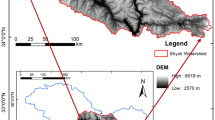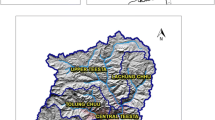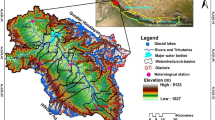Abstract
Melting glaciers are mostly associated with formation of proglacial lakes and the expansion of existing glacial lakes in Himalayan region. These expanding glacial lakes can induce the risk of glacial outburst floods that pose a great potential threat to natural resources and human lives. In Sikkim Himalaya, South Lhonak lake (SLL) (5200 masl) is rapidly expanding over the few decades due to the ongoing glacier melting. We recorded that the lake size increased from 0.20 ± 0.020 to 1.31 ± 0.001 km2 with the length change of 1.6 km during the period from 1976 to 2016. The average rate of expansion was recorded of 0.027 km2 per year; however, it increased drastically since 2000. The in situ-based bathymetric study of SLL showed that the storage volume was 65.81 ± 2.5 million m3 and maximum and average depths were 131 ± 2.5 and 67.05 ± 2.5 m, respectively. We observed that the substantial calving of ice bodies during the melting seasons and partly from the melting of North Lhonak glacier and flow of the Lhonak lake have contributed in expansion of SLL. We have also proposed an empirical equation of volume–area relationship to calculate the storage capacity of similar moraine-dammed glacial lakes in the Himalaya. In addition, we have suggested effective precautionary and mitigation measures to minimize the risk of GLOFs in future. The present study provides vital inputs for hydrodynamic modelling for flood simulation of potentially vulnerable lakes and to formulate the effective strategies in disaster risk reduction and mitigation plan in minimizing the threat of GLOFs.






Similar content being viewed by others
Change history
14 May 2018
In figure 6 the label of the x-axis was accidentally deleted during typesetting. The original article has been corrected.
References
Allen SK, Rastner P, Arora M, Huggel C, Stoffel M (2015) Lake outburst and debris flow disaster at Kedarnath, June 2013: hydrometeorological triggering and topographic predisposition. Landslides. https://doi.org/10.1007/s10346-015-0584-3
Ashraf A, Naz R, Roohi R (2012) Glacial lake outburst flood hazards in Hindukush, Karakoram and Himalayan Ranges of Pakistan: implications and risk analysis. Geomat Nat l Hazards Risk 3(2):113–132. https://doi.org/10.1080/19475705.2011.615344
Bajracharya SR, Mool PK (2009) Glaciers, glacial lakes and glacial lake outburst floods in the Mount Everest region, Nepal. Ann Glaciol 50(53):81
Bajracharya SR, Mool PK, Shrestha BR (2006) The impact of global warming on the glaciers of the Himalaya. In: Proceedings of the international symposium on geo-disasters, infrastructure management and protection of world heritage sites, Nepal Engineering College, Ehime College and National Society for Earthquake Technology, Nepal, 25–26 November 2006, pp 231–242
Bajracharya SR, Mool PK, Shrestha BR (2007) Impact of climate change on Himalayan glaciers and glacial lakes: case studies on GLOF and associated hazards in Nepal and Bhutan. International Centre for Integrated Mountain Development and United Nations Environment Programme Regional Office Asia and the Pacific, Kathmandu. ISBN 9789291150328, ICIMOD
Basnet S, Kulkarni AV, Bolch T (2013) The influence of debris cover and glacier lakes on the recession of glaciers in Sikkim Himalaya, India. J Glaciol 59(218):1035–1046. https://doi.org/10.3189/2013JoG12J184
Benn DI, Bolch T, Hands K, Gulley J, Luckman A, Nicholson LI, Quincey DJ, Thompson S, Toumi R, Wiseman S (2012) Response of debris-covered glaciers in the Mount Everest region to recent warming and implications for outburst flood hazards. Earth Sci Rev 114:156–174
Bhargava ON (1995) Geology, environmental hazards and remedial measures of the Lunana area, Gasa Dzongkhag: report of 1995 Indo-Bhutan expedition. Geological Survey of India, Kolkata
Bolch T, Buchroithner MF, Peters J, Baessler M, Bajracharya S (2008) Identification of glacier motion and potentially dangerous glacial lakes in the Mt. Everest region/Nepal using spaceborne imagery. Nat Hazards Earth Syst Sci 8:1329–1340. https://doi.org/10.5194/nhess-8-1329-2008
Breien H, De Blasio FV, Elverhoi A, Hoeg K (2008) Erosion and morphology of a debris flow caused by a glacial lake outburst flood, Western Norway. Landslide. https://doi.org/10.1007/s10346-008-0118-3
Carey M (2005) Living and dying with glaciers: people’s historical vulnerability to avalanches and outburst floods in Peru. Glob Planet Change 47(2–4):122–134
Carey M (2008) Disasters, development, and glacial lake control in twentieth century. In: Wiegandt E (ed) Mountain: sources of water, sources of knowledge, vol 31. Advance in global change research. Springer, Dordrecht, pp 181–196
Carey M, Huggel C, Bury J, Portocarrero C, Haeberli W (2012) An integrated socio-environmental framework for glacier hazard management and climate change adaptation: lessons from Lake 513, Cordillera Blanca, Peru. Clim Change 112(3–4):733–767
Chalise SR, Shrestha ML, Budhathoki KP, Shrestha MS (2005) Glacio-hydrological aspects of climate change in the Himalayas: mitigation of glacial lake outburst floods in Nepal. In: Wagener T, Franks S, Gupta HV, Boegh E, Bastidas L, Nobre C, Galvao CDO (eds) Regional hydrological impacts of climate change-impact assessment and decision making, vol 295. IAHS Publ. IAHS Press, Wallingford, pp 309–316
Chettri N, Sharma E, Shakya B, Thapa R, Bajracharya B, Uddin K, Oli KP, Choudhury D (2010) Biodiversity in the eastern Himalayas: status, trends and vulnerability to climate change. Climate change impact and vulnerability in the eastern Himalayas-technical report 2, ICIMOD, Kathmandu, p 7
Clague JJ, Evans SG (2000) A review of catastrophic drainage of moraine-dammed lakes in British Columbia. Quat Sci Rev 19:1763–1783
Costa JE, Schuster RL (1988) The formation and failure of natural dams. Geol Soc Am Bull 100:1054–1068
Daoming X (1988) Characteristics of debris flow caused by outburst of Glacial lake in Boqu River, Xizang, China, 1981. Geo J 17:569–580
Dobhal DP, Gupta AK, Manish Mehta, Khandelwal DD (2013) Kedarnath disaster: facts and plausible causes. Curr Sci 105(2):171–174
Evans SG (1986) The maximum discharge of outburst floods caused by breaching of man-made and natural dams. Can Geotech J 23(3):385–387
Fujita K, Suzuki R, Nuimura T, Sakai A (2008) Performance of ASTER and SRTM DEMs, and their potential for assessing Glacial Lakes in the Lunana region, Bhutan Himalaya. J Glaciol 54:220–228
Fujita K, Sakai A, Nuimura T, Yamaguchi S, Sharma RR (2009) Recent changes in Imja Glacial Lake and its damming moraine in the Nepal Himalaya revealed by in situ surveys and multi-temporal ASTER imagery. Environ Res Lett. https://doi.org/10.1088/1748-9326/4/4/045205
Gardelle J, Arnaud Y, Berthier E (2011) Contrasted evolution of glacial lakes along the Hindu Kush Himalaya mountain range between 1990 and 2009. Glob Planet Change 75:47–55. https://doi.org/10.1016/j.gloplacha.2010.10.003
Govindha Raj KB (2010) Remote sensing based hazard assessment of glacial lakes: a case study from Zanskar basin, Jammu & Kashmir. Geom Nat Hazards Risk 1:339–347
Govindha Raj KB, Kumar KV, Remya SN (2012) Remote sensing based inventory of glacial lakes in Sikkim Himalaya: semi-automated approach using satellite data. Geom Nat Hazards Risk. https://doi.org/10.1080/19475705.2012.707153
Govindha Raj KB, Remya SN, Kumar KV (2013) Remote sensing-based hazard assessment of glacial lakes in Sikkim Himalaya. Curr Sci 104(3):359–364
Grabs WE, Hanisch J (1993) Objectives and prevention methods for glacier lake outburst floods (GLOFS). In: Young GJ (ed) Snow and glacier hydrology. Proceedings of Kathmandu symposium, November 1992. IAHS Publ., vol 218, pp 341–352
Hall DK, Bayr KJ, Schöner W, Bindschadler RA, Chien JYL (2003) Consideration of the errors inherent in mapping historical glacier positions in Austria from the ground and space (1893–2001). Remote Sens Environ 86:566–577
Huggel C, Kaab A, Haeberli W, Teysseire P, Paul F (2002) Remote sensing based assessment of hazards from glacier lake outbursts: a case study in the Swiss Alps. Can Geotech J 39:316–330
Huggel C, Haeberli W, Kaab A, Bieri D, Richardson S (2004) An assessment procedure for glacial hazards in the Swiss Alps. Can Geotech J 41(6):1068–1083. https://doi.org/10.1139/T04-053
ICIMOD (2011) Glacial lakes and glacial lake outburst floods in Nepal. ICIMOD, Kathmandu
IPCC (2014) In: Core Writing Team, Pachauri RK, Meyer LA (eds) Climate change 2014: synthesis report. Contribution of working groups I, II and III to the fifth assessment report of the intergovernmental panel on climate change. IPCC, Geneva
Ives JD, Shrestha RB, Mool PK (2010) Formation of glacial lakes in the Hindu Kush-Himalayas and GLOF risk assessment. International Centre for Integrated Mountain Development, Kathmandu
Iwata S, Ageta Y, Naito N, Sakai A, Narama C, Karma (2002) Glacial lakes and their outburst flood assessment in the Bhutan Himalaya. Glob Environ Res 6:3–17
Jha LK, Khare D (2016) Glacial lake outburst flood (GLOF) study of Dhauliganga basin in the Himalaya. Cogent Environ Sci. https://doi.org/10.1080/23311843.2016.1249107
Kaltenborn BP, Nellemann C, Vistnes II (Eds) (2010) High mountain glaciers and climate change-challenges to human livelihoods and adaptation. United Nations Environment Programme, GRID-Arendal. www.grida.no. ISBN 978-82-7701-087-8. Accessed 10 Aug 2017
Kattelmann R (2003) Glacial lake outburst floods in the Nepal Himalaya: a manageable hazard. Nat Hazards 28(1):145–154. https://doi.org/10.1023/A:1021130101283
Kattelmann R, Watanabe T (1997) Draining himalayan glacial lakes before they burst. Destructive water: water-caused natural disasters, their abatement and control. In: Proceedings of the conference held at Anaheim, California, June 1996. IAHS Publ. No. 239
Kendra W, Singleton L (1987) Morphometry of Lake Chelan. Ecology report no. 87-1. Water Quality Investigations Section, Washington State Department of Ecology, Olympia WA 98504-68111
Khanal NR, Mool PK, Shrestha AB, Rasul G, Ghimire PK, Shrestha RB, Joshi SP (2015) A comprehensive approach and methods for glacial lake outburst flood risk assessment, with examples from Nepal and the transboundary area. Int J Water Resour Dev 31(2):219–237. https://doi.org/10.1080/07900627.2014.994116
Kirkbride MP (1993) The temporal significance of transitions from melting to calving termini at glaciers in the central Southern Alps of New Zealand. The Holocene 3:232–240
McFeeters SK (1996) The use of normalized difference water index (NDWI) in the delineation of open water features. Int J Remote Sens 17:1425–1432
Mool PK (1995) Glacier lake outburst floods in Nepal. J Nepal Geol Soc 11:273–280
Mool PK, Bajracharya SR (2003) Tista Basin, Sikkim Himalaya inventory of glaciers, glacial lakes, and the identification of potential glacial lake outburst floods (GLOFs) affected by global warming in the mountains of Himalayan region. ICIMOD, Kathmandu, p 145
Mool PK, Bajracharya SR, Joshi SP (2001) Inventory of glaciers, Glacial lakes and Glacial lake outburst floods: monitoring and early warning systems in the Hindu Kush-Himalayan region, Nepal. International Centre for Integrated Mountain Development with United Nations Environment Programme/Regional Resource Centre for Asia and the Pacific (UNEP/RRC-AP), Kathmandu
Nie Y, Liu Q, Liu S (2013) Glacial lake expansion in the central Himalayas by landsat images, 1990–2010. PLoS ONE 8(12):e83973. https://doi.org/10.1371/journal.pone.0083973
Osti R, Bhattarai TN, Miyake K (2011) Causes of catastrophic failure of Tam Pokhari moraine dam in the Mt. Everest region. Nat Hazards. https://doi.org/10.1007/s11069-011-9723-x:1209-23
Petrakov DA, Tutubalina OV, Aleinikov AA, Chernomorets SS, Evans G, Kidyaeva VM, Krylenko IN, Norin SV, Shakhmina S, Seynova IB (2011) Monitoring of Bhaskara Glacier lakes (Central Caucasus Russia) and modeling of their potential outburst. Nat Hazards. https://doi.org/10.1007/s11069-011-9983-5
Qinghua F (1991) Characteristics of glacier outburst flood in the Yarkant River, Karakoram Mountains. Geo J 25(2–3):255–263
Rana B, Shrestha AB, Reynolds JM, Aryal R, Pokhrel AP, Budhathoki KP (2000) Hazard assessment of the Tsho Rolpa Glacier lake and ongoing remediation measures. J Nepal Geol Soc 22:563–570
Richardson SD, Reynolds JM (2000) An overview of glacial hazards in the Himalayas. Quat Int 65:31–47
Rohl K (2006) Thermo-erosional notch development at fresh-water-calving Tasman Glacier, New Zealand. J Glaciol 52:203–213
Sakai A, Chikita K, Yamada T (2000) Expansion of a moraine-dammed glacial lake, Tsho Rolpa, in Rolwaling Himal, Nepal Himalaya. Limnol Oceanogr 45:1401–1408. https://doi.org/10.4319/lo.2000.45.6.1401
Sakai A, Fujita K, Yamada T (2003) Volume change of Imja Glacial Lake in the Nepal Himalayas. December 7th–10th, 2003 ISDB 2003 Niigata
Sarp G, Ozcelik M (2017) Water body extraction and change detection using time series: a case study of Lake Burdur, Turkey. J Taibah Univ Sci 11:381–391. https://doi.org/10.1016/j.jtusci.2016.04.005
Sharma RK, Shrestha DG (2016) Climate perceptions of local communities validated through scientific signals in Sikkim Himalaya, India. Environ Monit Assess 188:578. https://doi.org/10.1007/s10661-016-5582-y
Sharma E, Chettri N, Tse-ring K, Shrestha AB, Jing F, Mool P, Eriksson M (2009) Climate change impacts and vulnerability in the eastern Himalayas. ICIMOD, Kathmandu, pp 5–6
Shijin W, Dahe Q, Cunde X (2015) Moraine-dammed lake distribution and outburst flood risk in the Chinese Himalaya. J Glaciol 61(225):115. https://doi.org/10.3189/2015JoG14J097
Shrestha AB, Aryal R (2011) Climate change in Nepal and its impact on Himalayan glaciers. Reg Environ Change. https://doi.org/10.1007/s10113-010-0174-9:65-77
Shrestha BB, Nakagawa H (2014) Assessment of potential outburst floods from the Tsho Rolpa glacial lake in Nepal. Nat Hazards 71:913–936
Shrestha AB, Rana B, Aryal R, Pokhrel AP (2001) Hazard assessment and remediation work at Tsho Rolpa glacier lake, Rolwaling Himal, Nepal. J Jpn Soc Civ Eng 86:72–75
Shrestha AB, Budhathoki KP, Shrestha RK, Adhikari R (2004) Bathymetric survey of Tsho Rolpa Glacier Lake-2002. J Hydrol Meteorol 1(1):13–15
Somos-Valenzuela MA, McKinney MA, Byers AC, Rounce DR (2013) Bathymetric Survey of Imja Lake, Nepal in 2012. CRWR online report 12-06. http://highmountains.org/sites/default/files/Somos_CRWRonlineRpt12_BathymetryImja_revised.pdf. Accessed 8 Nov 2017
TanDong Y, ZhiGuo L, Wei Y, XueJun G, LiPing Z, ShiChang K, YanHong W, WuSheng Y (2010) Glacial distribution and mass balance in the Yarlung Zangbo River and its influence on lakes. Chin Sci Bull 55(20):2072–2078. https://doi.org/10.1007/s11434-010-3213-5
Taube CM (2000) Instructions for winter lake mapping. Chapter 12. In: Schneider JC (ed) Manual of fisheries survey methods II: with periodic updates, vol 25. Fisheries special report. Michigan Department of Natural Resources, Ann Arbor
Walder JS, Costa JE (1996) Outburst floods from glacier-dammed lakes: the effect of mode of lake drainage on flood magnitude. Earth Surf Proc Land 21:701–723. https://doi.org/10.1002/(ISSN)1096-9837
Wang S, Zhang T (2013) Glacial lakes change and current status in the central Chinese Himalayas from 1990 to 2010. J Appl Remote Sens 7(1):073459. https://doi.org/10.1117/1.JRS.7.073459
Wang X, Liu SY, Guo WQ, Xu JL (2008) Assessment and simulation of glacier lake outburst floods for Longbasaba and Pida Lakes, China. Mt Res Dev 3:310–317
Wang X, Liu S, Yao X, Guo W, Yu P, Xu J (2010) Glacier lake investigation and inventory in the Chinese Himalayas based on the remote sensing data. Acta Geogr Sinica 65(1):29–36
Wessels RL, Kargel JS, Kieffer HH (2002) ASTER measurement of supraglacial lakes in the Mount Everest region of the Himalaya. Ann Glaciol 34:399–408
Westoby MJ, Glasser NF, Brasington J, Hambrey MJ, Quincey DJ, Reynolds JM (2014) Modelling outburst floods from moraine-dammed glacial lakes. Earth Sci Rev 134:137–159. https://doi.org/10.1016/j.earscirev.2014.03.009
Williams RS Jr, Hall DK, Sigurdsson O, Chien JYL (1997) Comparison of satellite-derived with ground-based measurements of the fluctuations of the margins of Vatnajökull, Iceland, 1973–92. Ann Glaciol 24:72–80
Worni R, Huggel C, Stoffel M (2013) Glacial lakes in the Indian Himalayas-From an area-wide glacial lake inventory to onsite and modeling based risk assessment of critical glacial lakes. Sci Total Environ. https://doi.org/10.1016/j.scitotenv.2012.11.043
Worni R, Huggel C, Clague JJ, Schaub Y, Stoffel M (2014) Coupling glacial lake impact, dam breach, and flood processes: a modeling perspective. Geomorphology 224:161–176
Yamada T (1992) Report for the first research expedition to Imja Glacier Lake, 25 March to 12 April 1992. WECS report no 3/4/120892/1/1, seq. no. 412. WECS/JICA, Kathmandu
Yamada T (1998) Glacier lake and its outburst flood in the Nepal Himalaya. Monograph No. 1, March 1998. Data Centre for Glacier Research, Japanese Society of Snow and Ice, Nagoya
Yamada T, Sharma CK (1993) Glacier lakes and outburst floods in the Nepal Himalaya. In: Symposium at Kathmandu 1992—snow and glacier hydrology. IAHS Publ., vol 218, pp 319–330
Yao X, Liu S, Sun M, Wei J, Guo W (2012) Volume calculation and analysis of the changes in moraine-dammed lakes in the north Himalaya: a case study of Longbasaba lake. J Glaciol 58(210):753–760. https://doi.org/10.3189/2012JoG11J048
Acknowledgements
This study was supported by the Department of Science and Technology, Government of India (vide. Sanction order no. DST/CCP/GLOF-Sikkim/2013-2) and the Department of LR&DM, Government of Sikkim. We acknowledge the facilities and support provided by USGS-Earth Explorer for free access to Landsat images and Sikkim State Remote Sensing Applications Centre for use of RS & GIS Laboratory. We are thankful to the Principal Secretary, DST&CC-Sikkim for encouraging research and the scientific team of SCST-Sikkim, Indian Army, ITBP personnel and all the team members of expedition including the field staffs for their support during the field study. Special thanks to Dr. Sonam Wangchuk, SECMOL, Leh-Ladakh, for his support during the field study and Dr. Shiva K. Sharma, RCIBSD-Sikkim, for language correction of the manuscript. Authors would like to thank the Editor in Chief and the anonymous reviewers for their constructive suggestions to the revised manuscript.
Author information
Authors and Affiliations
Corresponding author
Additional information
The original version of this article was revised: In the original online publication the label “Area (km2)” was omitted from the x-axis of figure 6.
Rights and permissions
About this article
Cite this article
Sharma, R.K., Pradhan, P., Sharma, N.P. et al. Remote sensing and in situ-based assessment of rapidly growing South Lhonak glacial lake in eastern Himalaya, India. Nat Hazards 93, 393–409 (2018). https://doi.org/10.1007/s11069-018-3305-0
Received:
Accepted:
Published:
Issue Date:
DOI: https://doi.org/10.1007/s11069-018-3305-0




